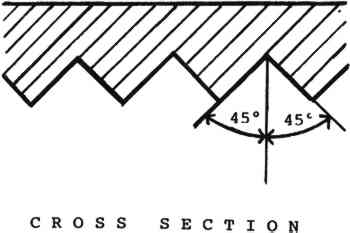LIGHT PIPING: A NEW LIGHTING SYSTEM FOR MUSEUM CASESCATHERINE SEASE
2 PRISMATIC FILMThe main component of the light piping system is a prismatic film manufactured by 3M Corporation. Originally marketed as Scotch Lamp Film, it is now called 3M Optical Lighting Film. Utilizing the physical principle of total internal reflection (see below), a pipe of this film transports light, transforming a point source of light evenly into a uniform linear or area source. Optical Lighting Film is made of either transparent acrylic or polycarbonate polymer in sheet form approximately 20 mils thick (Saxe 1989). Lightweight and flexible, it is smooth on one side and grooved on the other (fig. 1). These grooves are actually precise tiny prisms on 14 mil centers (Saxe et al. 1986) that are responsible for the light piping system's high efficiency in propagating light. Acting as total internal reflection mirrors, these prisms prevent light from escaping from the pipe. This efficiency is increased by the fact that little light is absorbed by the transparent, colorless prismatic film. In fact, light actually spends very little time in the thin film wall, traveling predominantly through the nonabsorptive air within the pipe (Saxe et al. 1986).
|
